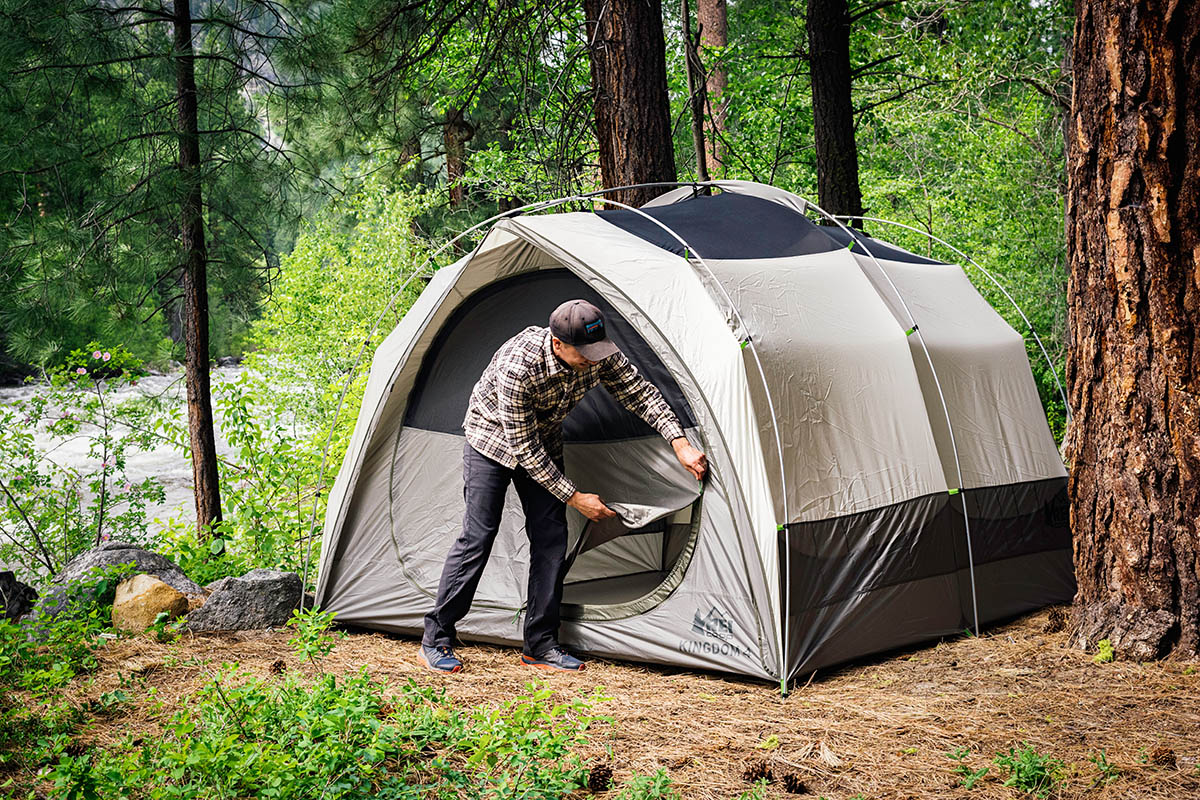I. Introduction to Tent Waterproofing

A. Understanding the Importance of Waterproofing Your Tent
Waterproofing your tent is crucial for ensuring a comfortable and dry camping experience. It protects you and your gear from rain, moisture, and the potential discomfort of a wet tent. A waterproof tent is essential for staying dry, warm, and safe in unpredictable weather conditions.
B. Benefits of a Waterproof Tent
A waterproof tent offers numerous benefits. It provides protection against rain, snow, and condensation, keeping you dry and comfortable. It also helps prevent the growth of mold, mildew, and rot, which can damage the tent fabric. Additionally, a waterproof tent prolongs the lifespan of your camping equipment.
C. Exploring Different Methods and Products for Waterproofing
There are various methods and products available for waterproofing tents. These include seam sealing, treating the rainfly or tent fly, and replenishing the durable water repellency (DWR) coating. Each method serves a specific purpose and can enhance the overall waterproof performance of your tent.
II. Assessing the Condition of Your Tent
A. Examining the Tent‘s Current Waterproofing Level
- Identifying Signs of Wear and Tear or Water Leakage Inspect your tent for signs of wear and tear, such as frayed seams, holes, or worn-out fabric. Look for any areas where water may be leaking into the tent.
- Assessing the Condition of Seams, Zippers, and Fabric Check the seams, zippers, and fabric of the tent for any damage or deterioration. Pay attention to any areas that may require extra attention during the waterproofing process.
B. Cleaning and Preparing the Tent for Waterproofing
- Properly Cleaning and Drying the Tent Thoroughly clean the tent by removing dirt, dust, and debris. Use a gentle soap and water solution, then rinse and air dry the tent completely before proceeding with waterproofing.
- Removing Dirt, Dust, and Mildew from the Surface Wipe down the tent with a damp cloth to remove any remaining dirt, dust, or mildew. Ensure that the tent is completely dry before continuing with the waterproofing process.
III. Seam Sealing for Enhanced Waterproofing
A. Identifying and Treating Vulnerable Seams

- Locating Seams in Need of Waterproofing Identify the seams on your tent that require waterproofing. These are typically areas where two pieces of fabric are stitched together.
- Understanding the Importance of Seam Sealing Seam sealing is crucial for preventing water from seeping through the needle holes in the fabric. It creates a watertight barrier along the seams to ensure maximum waterproofing.
B. Applying Seam Sealer to Ensure a Watertight Barrier
- Using the Correct Seam Sealing Product for Your Tent Material Choose a seam sealer specifically designed for your tent’s fabric type. Follow the manufacturer’s instructions for the appropriate product to use.
- Following the Manufacturer’s Instructions for Application Apply the seam sealer along the seams of your tent, ensuring even coverage. Use a brush or applicator provided with the product for precise application. Allow the sealer to dry completely before testing the tent for waterproofing.
IV. Waterproofing the Tent Fly or Rainfly

A. Understanding the Function of the Tent Fly/Rainfly
- Exploring the Purpose and Benefits of the Rainfly The tent fly or rainfly is an additional layer of protection that covers the main body of the tent. It helps shield the tent from rain, snow, and UV rays, providing an extra barrier against the elements.
- Assessing the Condition of the Rainfly and Any Needed Repairs Inspect the rainfly for any damages, such as rips, tears, or worn-out areas. Repair any issues before proceeding with waterproofing.
B. Applying a Waterproofing Spray or Treatment to the Rainfly
- Choosing the Right Waterproofing Spray for Your Tent Select a waterproofing spray or treatment specifically formulated for the material of your rainfly. Read the instructions and ensure the product is suitable for your tent fabric.
- Ensuring Even Coverage and Proper Drying for Optimal Results Apply the waterproofing spray or treatment evenly to the rainfly, following the manufacturer’s instructions. Ensure all areas are covered, paying particular attention to seams and high-stress areas. Allow the rainfly to dry completely before storing or using the tent.
V. Replenishing Durable Water Repellency (DWR) Coating
A. Understanding DWR and Its Importance

- Exploring the Role of DWR in Water Shedding Durable Water Repellency (DWR) is a coating applied to the tent fabric that helps water bead up and roll off the surface. It enhances the tent’s ability to shed water and prevents saturation.
- Assessing the Condition of the Tent’s DWR Coating Check the condition of the tent’s DWR coating. If water no longer beads up on the fabric, it may be time to replenish the coating.
B. Applying DWR Restorative Treatment to Reinforce Water Repellency
- Using the Appropriate DWR Restorative Product for Your Tent Material Choose a DWR restorative treatment specifically designed for your tent fabric. Follow the manufacturer’s instructions for the best application method.
- Following the Manufacturer’s Instructions for Application Apply the DWR restorative treatment to the tent fabric, ensuring even coverage. Pay attention to high-stress areas and allow the product to dry completely before testing the tent for water repellency.
VI. Routine Maintenance and Future Waterproofing
A. Regularly Inspecting and Maintaining Your Tent’s Waterproofing
- Checking for Signs of Wear, Damage, or Water Leakage Regularly inspect your tent for any signs of wear, damage, or water leakage. Address any issues promptly to prevent further damage and maintain the tent’s waterproof integrity.
- Performing Regular Cleaning and Spot Treatment for Longevity Clean your tent regularly, following proper cleaning techniques. Spot clean any areas that require attention to prevent the buildup of dirt, debris, or mildew.
B. Repeating Waterproofing Steps as Needed
- Recognizing the Signs for Reapplication of Waterproofing Products Monitor the performance of your tent’s waterproofing. If you notice a decrease in water repellency, it may be time to reapply seam sealer, waterproofing spray, or DWR restorative treatment.
-
Taking Necessary Steps to Ensure Ongoing Waterproof Performance Follow the waterproofing steps outlined in this guide as needed to maintain the waterproof performance of your tent. Regular maintenance and proper care will help extend the life of your tent and ensure you stay dry during your camping adventures.
Conclusion:
Waterproofing your tent is essential for maintaining a dry and comfortable camping experience. By assessing the condition of your tent, seam sealing, waterproofing the rainfly, and replenishing the DWR coating, you can enhance the tent’s resistance to water and moisture. Regular maintenance and future waterproofing efforts will prolong the life of your tent and keep you protected from the elements. Enjoy your outdoor adventures with a properly waterproofed tent that provides reliable shelter against rain and dampness.

